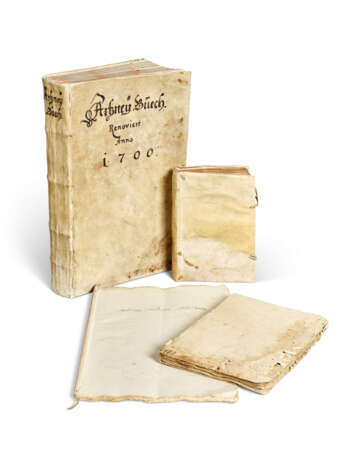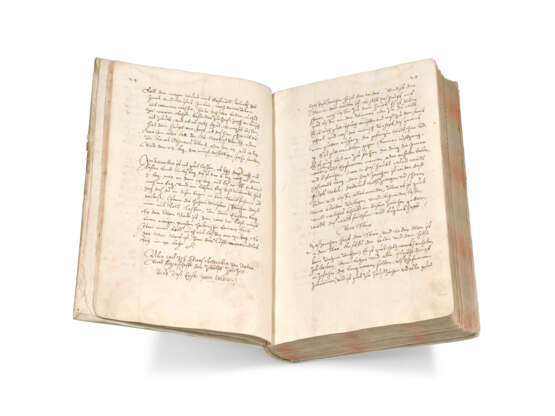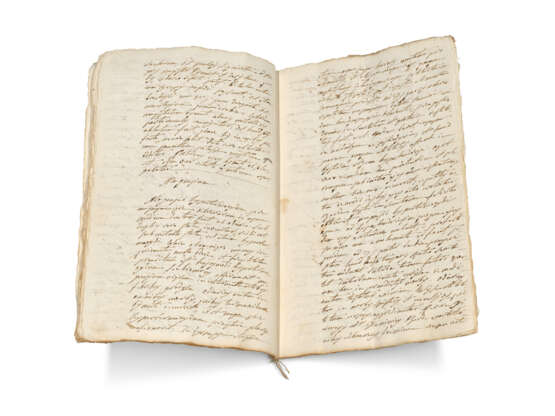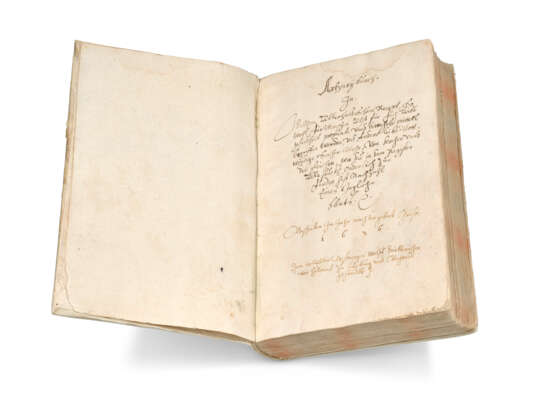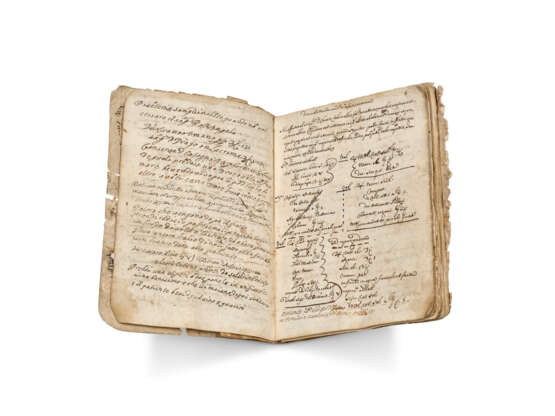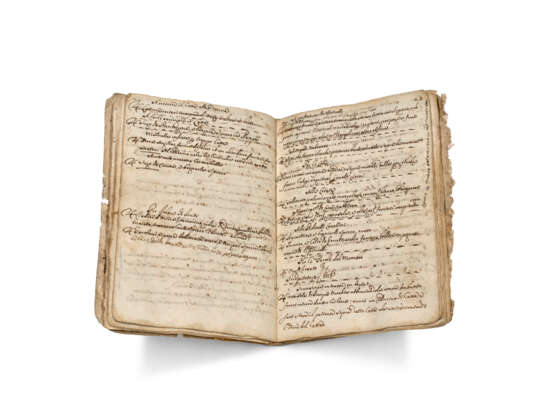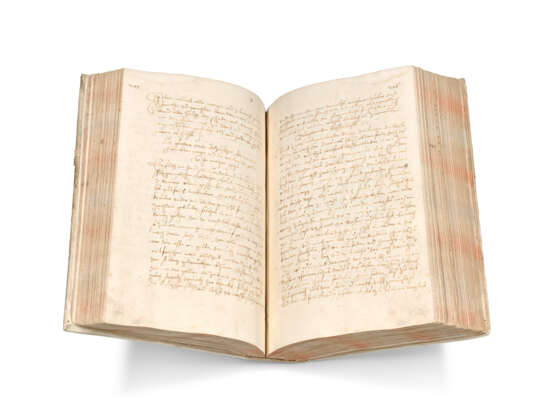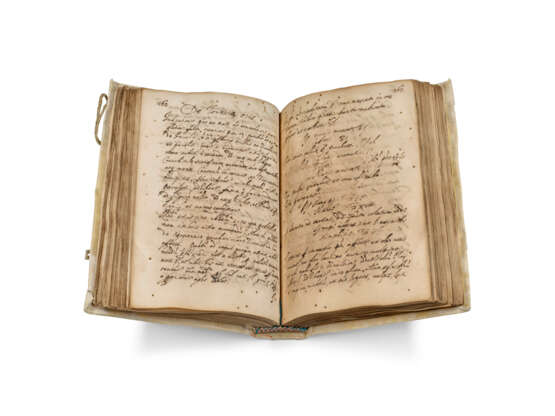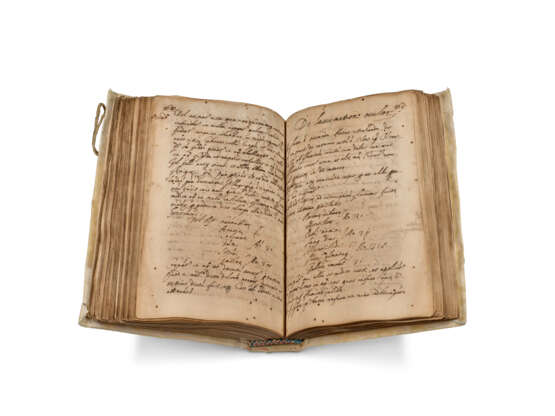ID 1349728
Lot 25 | A collection of medical recipes and pharmacopoeias
Valeur estimée
£ 5 000 – 7 000
Four manuscripts of pharmaceutical content, in German, Latin and Italian, manuscripts on paper [Germany and Italy, c.1600-18th century]
From lice infestations to swollen testicles: a collection of pharmacopoeias from the 17th and 18th centuries, providing a fascinating insight into early modern medicinal practice.
Four manuscripts:
(a) A German pharmacopoeia, in Latin, manuscript on paper, [Germany, c.1600].
153 x 110mm. i + 256 leaves, pagination 29-510 followed here, up to c.25 lines per page written in a cursive German Schrift (lacking leaves at beginning, some fading of text, occasional show-through, some soiling and wormholing). Bound in contemporary vellum (rebacked, a little yellowed, one of the ties lacking).
Contents: a pharmacopoiea with a particular focus on ophtalmology and otolaryngology, containing recipes to combat hair loss (p.29), itchiness (p.50), phthiriasis - or lice infestation (p.54), acne (p.57), head-aches (p.59), lethargy (p.123), depression (p.129), mania (p.152), memory lapses (p.169), dizziness (p.186), epilepsy (p.199), tremors (p.232), 'De Tortura oris', or facial tics, drawing on the work by Rhazes (p.262), arthritis (p.282), various diseases of the eyes (pp.309-388), of the ears (pp.389-416), of the nose (pp.417-445), and of the mouth and teeth (pp.445-510).
(b) The Pharmacopoiea of Wolf Dietrich von Hallwil, in German, manuscript on paper [Germany, Luxburg Castle?], 1636-1680s.
296 x 192 mm. 346 leaves, of which 92 blank, pagination 1-400, and 1-32 (4 pages missing in the pagination), varying number of lines written in a cursive script by several hands, 12 leaves bound in at the end with a separate treatise on Hungarian fever (some marginal thumbing and smudging, some minor dampstaining, else in good condition). 18th-century vellum over pasteboards (restored, the upper cover stained). Provenance: (1) Wolf Dietrich von Hallwil (1616-1695), of Luxburg Castle on the shores of Lake Constance: his ownership inscription on titlepage: 'Dem wolledlen gestrengen Wolff Dietterichen von Halweil zu Luxburg und Eberhouen gehörendt'. Schloss Luxburg came to the Hallwil heir Anna Sibilla, who in 1640 married Johann Rudolf von Westernach zu Kronburg (1608-1689), whose ancestral seat was at Kronburg near Memmingen (on Luxburg and the Hallwil family see J. Salzgeber, 'Aktenfund, die Luxburg bei Egnach betreffend', Thurgauische Beiträge zur vaterländischen Geschichte 123, 1986, pp.45-49). (2) Johann Karl von Westernach: his inscription on front flyleaf: 'Joannes Carolus Baro de Westernach, Dominus in Cronburg, Ebenhoven, Luxenburg, et Ottingen' and 'Ex. Biblioth: Cronburg: etc. Anno. MDCC. 1700' on inside upper cover.
Contents: Artzneybuoch in welchem allerhand schöne Recept, so wohl für Menschen als für Leibs gesundheit propierte vnd bewehrte mittell begriffen werden, vnd andere leibs nottwendige Sachen mehr, von Kochen vnd der gleichen [...] Geschriben im Jahr nach der geburt Christi 1636, a pharmacopoeia, beginning with an astrological treatise on the influence of the planets on the hours of the day, the days of the year, the signs of the zodiac and days of rest (pp.1-17), followed by medical recipes, effects of herbs, etc., quoting Aristotle, Galen, Seneca, a section on tree cultivation, and recipes added in different hands with the dates 1638 and 1646. At the end, on slightly larger paper, with the leaves folded in along the outer margin, there is a treatise on Hungarian fever, or 'Febris castrensis', an epidemic that was particularly rampant among military encampments in 1689.
(c) An Italian pharmacopoeia, in Latin and Italian, manuscript on paper [Italy, 18th century].
194 x 135mm. 70 leaves, foliation erratic and sporadic, varying number of lines in several hands, several crossings out, doodles, underlinings, etc. (soiling and smudging, occasional ink erosion and show-through of text, f.17 loose, one leaf from the index at the end torn out). Bound in contemporary ‘carta rustica’ pasteboards, the boards with offsetting from a 12th-century manuscript, a fragment of a papal bull dated 1554 sewed to the textblock to reinforce the spine (the binding frayed, worn and a little wormholed).
Contents: a working pharmacopeia, evidently much used and updated over the years by a number of budding pharmacists, containing Latin and Italian recipes dealing with, among other things: fevers, post-partum pains, period pains, instructions on how to avoid miscarriage, angina, dysentery, burns ('Secreto per le scottature'), a recipe to induce vomit, sore throats, inducing lactation, tooth-ache, swollen testicles, chapped lips, concussions, to treat a variety of wounds (neck, chest, stomach, etc), tinnitus.
(d) Materiae Medicinae Liber VII, in Latin, manuscript on paper [Italy, 18th century]
295 x 188mm. 20 leaves, plus one loose inserted leaf and two further slips of paper with recipes, varying number of lines in a cursive hand (edges frayed, some spots and thumbing). Paper binding.
Contents: 'Materiae Medicinae', a treatise discussing the medicinal preparation of and uses for: zinc (f.1), bismuth (f.5), magnesium (f.6v), copper (f.8), iron (f.11v).
| Lieu d'origine: | Europe de l'Ouest, Allemagne, Italie, Europe |
|---|---|
| Catégorie maison de vente aux enchères: | Manuscrits médiévaux et de la Renaissance, Livres et manuscrits |
| Lieu d'origine: | Europe de l'Ouest, Allemagne, Italie, Europe |
|---|---|
| Catégorie maison de vente aux enchères: | Manuscrits médiévaux et de la Renaissance, Livres et manuscrits |
| Adresse de l'enchère |
CHRISTIE'S 8 King Street, St. James's SW1Y 6QT London Royaume-Uni | |
|---|---|---|
| Aperçu |
| |
| Téléphone | +44 (0)20 7839 9060 | |
| Commission | see on Website | |
| Conditions d'utilisation | Conditions d'utilisation |
